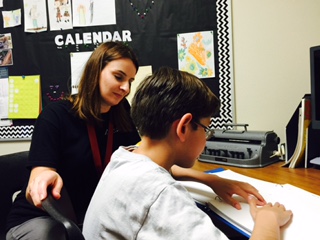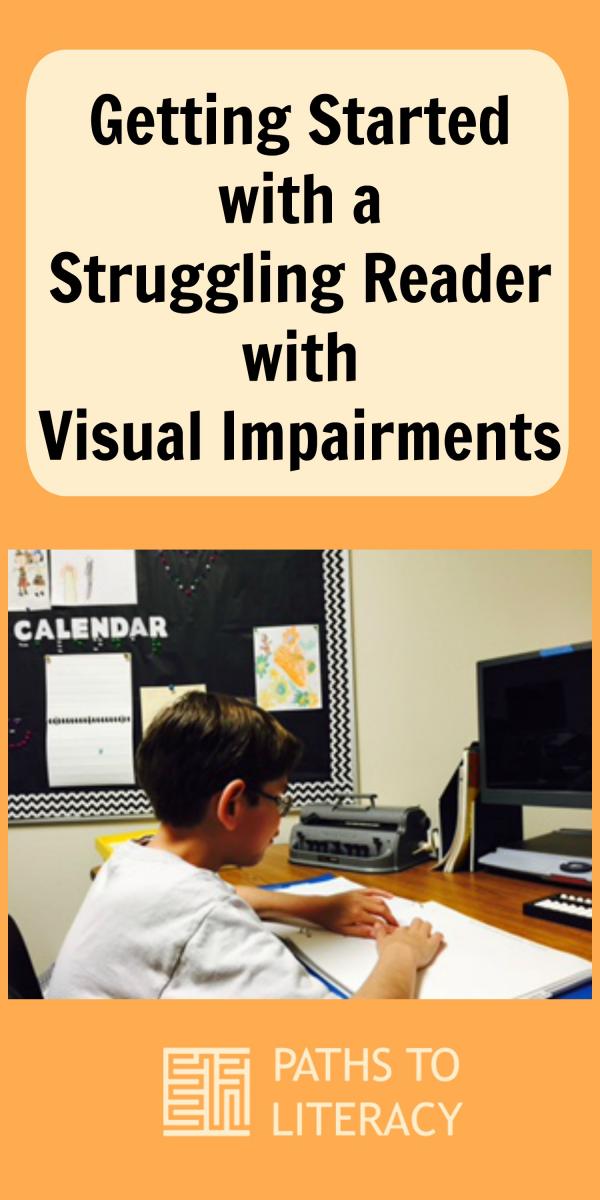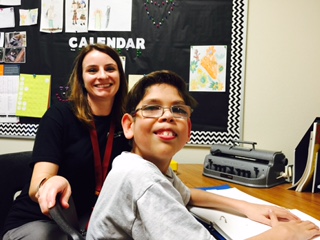Parents and Teachers of the Visually Impaired (TVI) often have questions about struggling readers. These are:
- How do reading skills develop in children?
- How does this development vary for children with visual impairment?
- How can parents encourage early literacy?
- What are early signs of a struggling reader?
- Are there ways to separate reading difficulties from the visual impairment? (Note: This topic will be addressed in a future post.)
- What are characteristics of a struggling reader in elementary and middle schools?
- What educational interventions are available?
- What will happen in the future?
How do reading skills develop in children?
 Melissa brought her infant son, Trey, home from the hospital with the knowledge that he would be a braille learner. She had two older sons who were doing well in school, but wondered how she could encourage school readiness in general for Trey. She knew that his needs would be different but just how different? What would be the best strategies she could use during the early years of his development?
Melissa brought her infant son, Trey, home from the hospital with the knowledge that he would be a braille learner. She had two older sons who were doing well in school, but wondered how she could encourage school readiness in general for Trey. She knew that his needs would be different but just how different? What would be the best strategies she could use during the early years of his development?
Everything suggests that reading is one of the more complex tasks that a child will master. It requires multiple abilities for children with vision as well as those with visual impairments. Some of the requirements for all children are:
- Certain level of cognitive as well as language abilities
- An efficient means of processing information
- Basic experiences to support the concepts they learn through reading
- Regular practice in reading in different environments and for different purposes
Any child with a visual impairment will have some additional challenges as they develop reading skills. These will need to be mastered in addition to those listed above. Some of these include:
- Development of special skills such as the use of Low Vision devices and/or braille
- Enriched environments that allow them to experience various activities that help them build concepts
- Special efforts to be sure that the child sees coded language, i.e. written words in their world
How can parents support early literacy? Why does it not always result in fluent readers?
Melissa realized how important experiences were for Trey. She also wanted to be sure that braille was a regular part of his world. The whole family participated in helping Trey build his vocabulary and concepts. hey went around the house and found different shapes of tables. They went to a petting zoo and explored different ways that “soft” might feel. Everyone tried to ensure that Trey really “knew” all about the words he was using in his vocabulary. To help Trey understand that words could help in many ways, Melissa put braille labels on the microwave and other kitchen appliances. Melissa bought braille books and read them each night. Trey could follow along with “reading” by touching the braille. Melissa was proud that Trey could sing the alphabet song independently by age 2 ½. He was able to read the braille letters of a through c. Trey was always interested in “reading” the braille labels in his house. When Trey started more formal educational programs at age 3, Melissa was confident that he would be able to start reading when he reached kindergarten. His background was solid, and the interest was there.
Parents can provide a solid background of concepts, experiences, and exposure to words. Initial observations indicate a clear readiness to read, however struggles soon become apparent when formal instruction in reading begins.
- Reasons for the struggles are not always apparent.
- The difficulties are often not seen in early childhood.
- Formal reading instruction will frequently be the first indicator of problems.
- The good memories of many children with visual impairment may help mask later difficulties.
What are the early signs of a struggling reader?
 Trey was now in first grade, and had made little progress in reading braille. He was able to show good hand skills and could track from left to right. He recognized approximately half of the alphabet but often confused them in the context of words. He continued to enjoy having stories read to him, but was less and less willing to try to read the simple books the teacher sent home. The parents advocated for additional services from the TVI in hopes that would improve his reading skills. Melissa began to wonder if there were difficulties with processing of information. She wondered about the early signs of a struggling reader who is also a braille reader.
Trey was now in first grade, and had made little progress in reading braille. He was able to show good hand skills and could track from left to right. He recognized approximately half of the alphabet but often confused them in the context of words. He continued to enjoy having stories read to him, but was less and less willing to try to read the simple books the teacher sent home. The parents advocated for additional services from the TVI in hopes that would improve his reading skills. Melissa began to wonder if there were difficulties with processing of information. She wondered about the early signs of a struggling reader who is also a braille reader.
In spite of good early intervention, some children will have difficulties with reading. For some children it is a temporary setback because they may be slower to mature. They will develop the skills at a slightly later age. Some children will never learn to read because of cognitive limitations. About 20% of all children will always have difficulties with reading. We don’t know how many children with visual impairments will have these types of difficulties, but think that it is at least 20% and probably more.
The early signs of a struggling reader are similar for print and braille learners. Many of these signs are present at an early age often when parents are reading to the child. Some of these signs are:
- Problems in remembering names of letters
- Reciting alphabet in a rote manner, often mispronouncing and confusing letters
- Difficulty in completing familiar rhymes or stories
- Little interest in “what is this word/letter” when parent is reading
- Little interest in “what is this word/letter” in environmental words
- Problems with rhyming words in stories. Cannot tell you what word might rhyme with another
- Problems in hearing the difference between different sounds
Do the signs of a struggling reader become different as they get older? Will it improve without intervention?
Reading skills had improved a little for Trey now that he was in the second grade, however Melissa was still concerned. Trey was very resistant to reading at home, and evenings often held some major battles to get the 10 minutes of reading done. Although Trey knew all of his letters and could read simple words and books, Melissa still knew that his skills were far below his peers. Melissa just did not know what might be related to the issues with learning braille. The TVI assured her that Trey was making good progress with learning braille. Trey just could not put it all together to do much in the way of reading. Both continued to be curious about what behaviors might indicate significant problems with reading.
Once a child begins to read, there are some clear indicators that reading will not come easily to this child. Some of the indicators are:
- Lack of interest in reading
- Resistance to reading in any environment
- Problems in identifying the sounds that letters make
- Problems in recognizing the difference between the sounds of two letters
- Difficulty in remembering repeating words in stories
- Problems in repeating what has been read
When should other experts begin to help with the interventions? What resistance might be encountered?
 Melissa and the TVI began to think that it would be wise to have some additional intervention to determine what might be the problem. Once they determined the problem, they felt that intervention would be more efficient. However, they found that it was difficult to actually have any intervention since Trey was visually impaired. Other staff felt that this was not appropriate or even necessary. In their minds, any educational problem was best identified and met through the TVI. Melissa began a process of advocating for appropriate services to help plan an appropriate education for Trey.
Melissa and the TVI began to think that it would be wise to have some additional intervention to determine what might be the problem. Once they determined the problem, they felt that intervention would be more efficient. However, they found that it was difficult to actually have any intervention since Trey was visually impaired. Other staff felt that this was not appropriate or even necessary. In their minds, any educational problem was best identified and met through the TVI. Melissa began a process of advocating for appropriate services to help plan an appropriate education for Trey.
To support the need for intervention, it is important that all staff understand the relationship between vision and development of reading skills. Specifically they need to understand the following:
- Reading is primarily the result of a child’s ability to discriminate different sounds and the ways that they combine to form words.
- Visual-perceptual problems are infrequently the cause of reading difficulties.
- The TVI can provide appropriate information about the possible impact of visual impairment upon reading.
Early intervention is crucial to ensure successful readers and academic success
- Intervention during the first grade results in 90% of children “catching up” with their peers.
- Intervention during the fourth grade results in 20% of children overcoming their problems.
- Reading problems are a significant factor in students leaving school before graduation.
Who provides intervention in the school? How do students become eligible for this intervention?
Melissa now felt that Trey required additional support and that this could not be provided solely by the TVI. Her new challenge was to see how this could be provided, and to see what factors might limit the services. Melissa could see that Trey was making progress in his reading, but was concerned at how slow the progress was. In spite of the progress, he seemed to be falling further behind his peers each day. She needed to understand just how the intervention process worked. Being a good advocate always requires good knowledge.
Intervention services for reading improvement are broadly outlined by federal laws, but each state has developed their own procedures. General concepts that seem to be present in all are:
- Systematic intervention must occur and progress monitored before more formal testing occurs.
- TVI should be a part of planning the intervention .
- A reading specialist will also need to be an important part of planning intervention.
- The reading specialist will have a variety of titles in different schools and states.
- Actual services will be delivered in different environments but most often in a separate classroom.
- Parents frequently will need to advocate for these services to be accessible for their child.
- There is a continuing tendency in schools to feel that visual impairment is the reason for all problems.
- The TVI will need to provide clear information about the true implication of the visual impairment on the reading process during intervention.
- Parents will need to support efforts with home activities.
What will happen in the future?
 Melissa felt that Trey was now getting the services that he needed. He saw the reading specialist three times per week and his TVI four times per week. The family felt that he was progressing, and continued to work with Trey at home. They asked Trey to help read materials around the house, such as reading books aloud. They tried to think of everyday activities that required reading and asked Trey to help. He frequently read instructions and often brailled and read recipes for dinner. Melissa knew that some children would develop good reading skills after intervention and never need additional help. Melissa also knew that some children would continue to struggle. She wanted to learn if there were any indicators that Trey might continue to have problems.
Melissa felt that Trey was now getting the services that he needed. He saw the reading specialist three times per week and his TVI four times per week. The family felt that he was progressing, and continued to work with Trey at home. They asked Trey to help read materials around the house, such as reading books aloud. They tried to think of everyday activities that required reading and asked Trey to help. He frequently read instructions and often brailled and read recipes for dinner. Melissa knew that some children would develop good reading skills after intervention and never need additional help. Melissa also knew that some children would continue to struggle. She wanted to learn if there were any indicators that Trey might continue to have problems.
Predicting future problems is always difficult. There are some general indicators of continued reading difficulties. Like any predictor, these are not 100% correct but they provide some general information. Continued problems are more likely to be noted if there are problems with the following:
- Chooses extremely simple materials to read
- Has a reading level is far below vocabulary
- Skips words and does not seem to notice or correct
- Has trouble with basic sight words
- Reads a word differently each time that it appears
- Reads a word that makes no sense in the passage but does not notice
- Writing samples leave significant sounds out of words
- Can’t retell what has just been read
- Reads at a broken pace and with little expression





